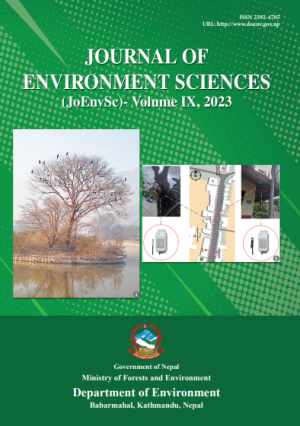Land Use and Cover Change Detection in Shankharapur Municipality, Kathmandu Using Spectral Indices
DOI:
https://doi.org/10.3126/jes.v9i1.56481Keywords:
Land Use Land Cover, NDBI, NDVI, Satellite ImageryAbstract
The surging increase of the urban population has been accompanied by a sharp increase in urban built-up areas. The growth of population contributing to rapid expansion of built-up area in recent decades has caused a substantial Land Use Land Cover (LULC) change across Nepal and in particular Kathmandu Valley (KV). In this study, a Normalized Difference Vegetative Index (NDVI) and Normalized Difference Built-up Index (NDBI) was applied to three Landsat imagery collected over time (2002, 2013, and 2022) and one Sentinel-2 imagery that provided recent and historical LULC conditions for, Shankharapur municipality that lies in the eastern part of Kathmandu. The three-land use land cover categories were identified and mapped from the value of NDBI and NDBI. We found that over a period of 20 years (from 2002 to 2022), the Shankharapur municipality has lost 14.64% and 25.97% of its forests and sparse vegetation, and increase in the settlement/open land by 5.48% and 226.73% as indicated by NDVI and NDBI for Landsat imagery respectively. The increase in settlement/open land can be summed to the augmented activities like constructing new building and increase forest and land defragmentation including construction of road and land planning to fulfill the demand of influx of people after the earthquake of 2015. The results of NDVI and NDBI from Sentinel-2 imagery also support the increase in settlement/open land and decrease in forest and sparse vegetation. Also, agriculture cover increased by 4.25 sq.km between 2002 to 2013 and increased by 4.85 sq.km. from 2013 to 2022 as indicated by NDVI derived from Landsat imagery. However, the significant amounts of losses of forest and sparse vegetation during 20 years have been absorbed by the expanding urbanized areas and agriculture land as more land is subjected to the built-up and land planning along with the wood-logging as a result of aftermath of the earthquake, 2015, where population has increased by 19.4 % in the span of 10 years from 2011 to 2021 and is never retreating in terms of changing land cover. Therefore, such trends if unchecked can result in loss of biodiversity and ecosystem services associated with deteriorating conditions for human well-being.




